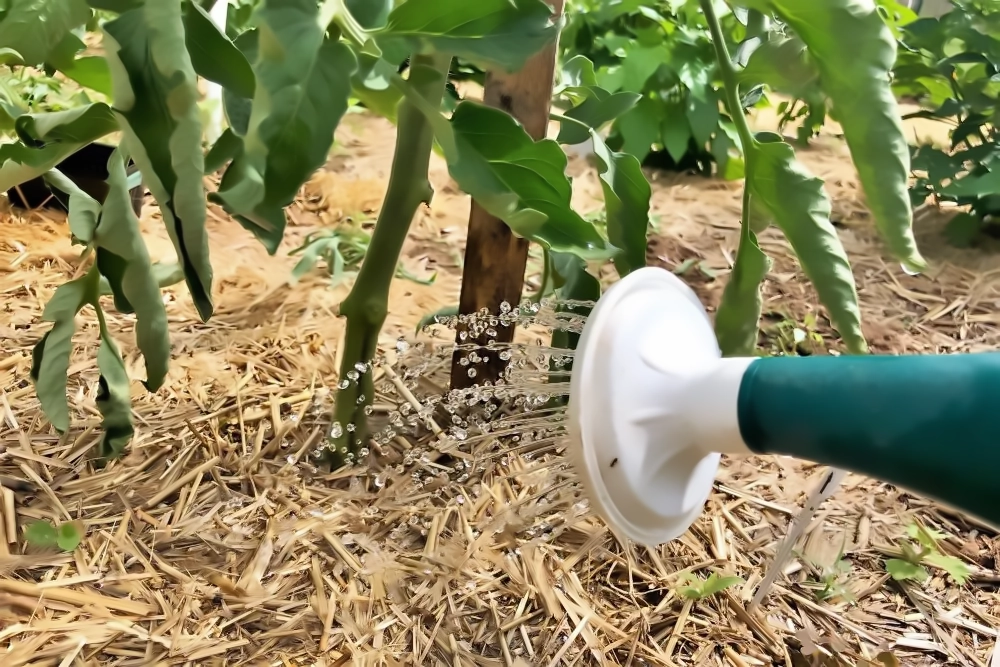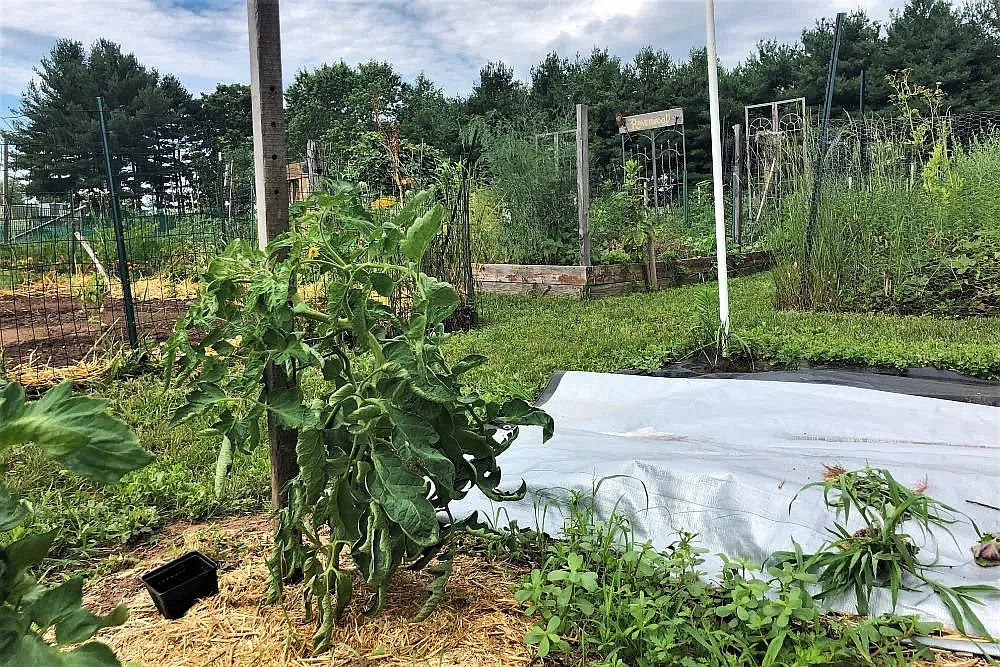Key Takeaways
– 🍃 Leaf mulch is considered the most beneficial mulch for tomatoes due to its advantages and cost-effectiveness.
– 🌾 Straw is a reliable and long-lasting mulch option for tomatoes, especially when leaves are not readily available.
– 🌲 Wood chips are a suitable organic mulch choice that slowly breaks down and releases nutrients into the soil.
– 🌱 Using low-growing plants as living mulch, such as alyssum, can help protect the soil, attract beneficial insects, and suppress weeds.
– 🍃 Lawn clippings and pine needles can be used as mulch, with the former drying out quickly and releasing nutrients.
– 🌽 Plastic mulch is a convenient option, but it should be used with caution and in specific colors to achieve desired effects.
– 💦 Mulching tomatoes helps retain moisture, prevent weed growth, add nutrients, protect against diseases, and improve garden aesthetics.
– ❓ FAQs provide information on the best mulch types for tomatoes, when to mulch, recommended amounts, and other related questions.
Best Mulch For Tomato Plants: Unveiling the Top Six Choices
Are you a passionate gardener, eagerly awaiting the day when your tomato plants yield an abundant harvest? If so, you’ve come to the right place. Tomatoes are a staple in many home gardens, and their succulent taste and vibrant color make them a favorite among vegetable enthusiasts. But did you know that the secret to growing healthy and productive tomato plants lies in choosing the best mulch? Yes, you heard it right – mulch plays a crucial role in the success of your tomato crop.
Mulching is a technique that involves covering the soil around plants with a protective layer of material. It not only enhances the beauty of your garden but also provides numerous benefits to your tomato plants. From conserving moisture to controlling weeds and maintaining optimal soil temperatures, mulch is a multitasking superhero for gardeners.
Two Mulches I Am Using For Tomato Plants This Year – And Why They Work for Me
Two Mulches I Am Using For Tomato Plants This Year – And Why They Work for Me
However, with so many options available in the market, selecting the best mulch for tomato plants can be a daunting task. Each type of mulch offers unique advantages and characteristics that can significantly impact the growth and productivity of your tomatoes. Are you wondering which mulch will be the perfect match for your tomato plants? Look no further! In this comprehensive guide, we will explore the top contenders for the title of the “Best Mulch for Tomato Plants.”
In this article, I will discuss the benefits of mulching tomatoes and why it is recommended to start using it. I will also provide information on various types of mulch to consider, as there are many options available.
Best Types Of Mulch for Tomato Plants
When choosing an ideal mulch for tomatoes, it is important to consider two factors.
- Mulches release nutrients. The best mulches consist of organic materials. In a forest, fallen leaves cover the ground and slowly break down, releasing nutrients and maintaining soil health.
- If mulch prevents water from reaching the tomato plant’s roots, it is not a good choice as the plant’s roots require water and certain materials may become hydrophobic if they dry out too often.
Taking into consideration these characteristics, let’s review some of the top mulches for tomatoes (as well as other garden vegetables).
1. Leaf Mulch
Leaf mulch is considered to be the most beneficial mulch for tomatoes due to its numerous advantages, and it is often accessible at no cost.
Forests are ecosystems where trees shed their leaves during the fall, replenishing the soil with nutrients and serving as a food source for beneficial animals and bacteria.
One can use leaves as a mulch.
- Collect the leaves during the autumn season.
- Finely chop the leaves using either a lawn mower or a weed whacker.
- The leaves should be left in a pile during the winter months for a minimum of 3-4 months.
- Using leaves as mulch in the spring is recommended.
If you are in need of leaves for your property, consider asking your neighbors if they have any to spare. Many people are happy to get rid of the leaves that accumulate on their lawn, and you can find a good use for them.
2. Straw
I have utilized straw as my main garden mulch for a number of years due to the lack of convenient access to free leaves. Straw is composed of dry stalks from cereal plants.
Straw may contain herbicides from the original cereal crop fields, which can persist and potentially affect your garden. It is advised to conduct a controlled test before using straw as mulch.
Using straw as mulch is a reliable and long-lasting option if you have a good source. It can be used for multiple years and is especially useful for transplanting tomatoes, peppers, and other seedlings in the spring.
3. Wood Chips
- Wood chips are commonly used as garden mulch in landscaping or shade gardens. There are several myths surrounding wood chips and their impact on the soil, but most of them are unfounded.
- There are misconceptions that wood chip mulch can make the soil acidic or steal nutrients from the soil. However, these claims are not true when the chips are used solely on the surface of the soil. It is not recommended to incorporate mulch into the soil.
- Wood chips are an organic mulch option that slowly break down and release nutrients back into the soil, making them a suitable choice for tomatoes if you have convenient access to them.
4. Living Mulch
So far, we have only covered the use of dead plant material as mulch. Another alternative is to plant low-growing plants around the base of your tomatoes to serve as mulch.
Alyssum can be used as a living mulch, growing to a height of 4-6 inches under tomato vines. It helps protect the soil, attract beneficial insects, and suppress weeds. Alyssum seeds can be obtained here.
This type of mulching requires more effort, but it can result in stunning gardens. I suggest trying it if you are growing tomatoes in pots by scattering seeds along the perimeter in early spring.
5. Lawn Clippings & Pine Needles
Lawn clippings can be used as mulch, as they dry out quickly and release nutrients.
It is important to avoid using grass clippings that have been treated with pesticides or herbicides on your lawn, as they can contaminate the soil and have negative effects on the growth and safety of your vegetables.
Pine needles can also be used for mulching. I have personally used pine needles around garlic and found them to be effective in allowing water to pass through. Contrary to popular belief, pine needles do not acidify the soil.
6. Plastic Mulch
- Although I have reservations about using plastic in the garden, it is undoubtedly a convenient and efficient mulch option. It is simple to install and does not create a mess when removing it at the end of the season.
- Different colors of plastic mulch can have different effects. Black plastic mulch can warm the soil for heat-loving vegetables, while white plastic can deter some insects.
- The basic technique involves laying out plastic mulch and cutting holes to plant seedlings. The holes should be sized to allow water to reach the soil and root systems.
Benefits Of Mulching Tomatoes
Now, let’s explore the numerous benefits of using mulch in the garden, with a focus on the best types for tomatoes.
- To prevent cracking in tomatoes, it is recommended to water them evenly and use mulch to retain moisture and slow down water evaporation, promoting better plant health.
- Mulch is effective in preventing weed growth, saving time and allowing for more productive gardening activities.
- Mulches add nutrients to the soil. Leaves, straw, wood chips, or grass clippings are broken down by bacteria and animals, releasing nutrients back into the soil. Tomatoes benefit from these nutrients. However, it is important to note that mulches are not a substitute for organic fertilizer.
- Mulching tomatoes can help decrease disease. The mulch absorbs rainwater and prevents soil from splashing onto lower leaves. This keeps the lower parts of tomatoes clean after heavy rainfall. Another suggestion is to try disease-resistant varieties.
- Mulch protects the soil from erosion caused by sunlight, wind, and precipitation. It maintains the microbiome and structure of the soil. I keep my mulch in place during fall and winter to protect my garden soil throughout the year.
- Reflective or brightly colored mulch is known for potentially confusing certain pests. While not a primary reason for using mulch, it can provide an additional benefit if dealing with specific pests.
Mulching tomatoes can improve garden aesthetics, which may be important to some growers as it keeps the garden looking clean and attractive.
The appearance of soil can vary depending on whether it is raw or mulched. Neatly mulched gardens tend to be more visually appealing. The type of mulch used will also play a role in the overall effect. Additionally, mulch helps to prevent plants from becoming dirty after a rainstorm.
FAQs: Best Mulch For Tomato Plants
1. What is the best mulch for tomato plants?
The best mulch for tomato plants is organic mulch like straw, wood chips, or compost. These types of mulch help retain moisture, prevent weeds, and add nutrients to the soil.
2. How does mulch benefit tomato plants?
Mulch benefits tomato plants by retaining moisture, preventing weed growth, adding nutrients to the soil, and protecting the plants from soil-borne diseases.
3. When should I mulch my tomato plants?
You should mulch your tomato plants after they have been transplanted and are well-established, typically a few weeks after planting.
4. How much mulch should I use for my tomato plants?
A layer of 2-3 inches of mulch is typically sufficient for tomato plants. This amount helps retain moisture and prevent weeds without smothering the plants.
5. Can I use grass clippings as mulch for my tomato plants?
Yes, grass clippings can be used as mulch for tomato plants. However, make sure the grass has not been treated with any chemicals that could harm the plants.
6. Can mulch help prevent diseases in tomato plants?
Yes, mulch can help prevent soil-borne diseases in tomato plants by preventing soil from splashing onto the lower leaves of the plants.
7. Can I use plastic mulch for my tomato plants?
Yes, plastic mulch can be used for tomato plants, especially red or black plastic. This can help warm the soil and retain moisture, but it does not add nutrients to the soil like organic mulches.
8. How often should I replace the mulch around my tomato plants?
Mulch around tomato plants should be replaced once it has decomposed, typically once a year. This ensures the plants continue to receive the benefits of the mulch.
9. Can mulch help with pest control in my tomato garden?
Yes, some types of mulch, like cedar bark, can help repel certain pests. Additionally, mulch can create a habitat for beneficial insects that prey on common garden pests.
10. Can I use newspaper as mulch for my tomato plants?
Yes, newspaper can be used as a form of mulch. It is best to wet the newspaper and layer it around the plants, then cover it with another type of mulch like straw or wood chips.



